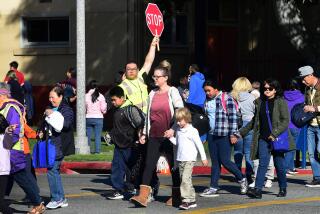Emphasis on Buckling Up the Kids : Project Stresses Safety for Children in Autos
- Share via
Remember those wonderful old movies and television shows about American family life?
The newborn baby is pink and beautiful, and when the time comes to go home from the hospital, daddy helps mommy into the faithful Chevrolet, gently places the blanket-swathed infant in her lap, gets into the car and they drive off into suburbia.
Beautiful, romantic . . . but terribly wrong, say those who are preoccupied with the fact that auto accidents kill or injure more people than any other kind of accident--needlessly.
“The new idea is that everyone is buckled up,” said Stephanie Tombrello, executive director of the Inglewood-based Los Angeles Area Child Passenger Safety Assn. This means that mom and dad are wearing seat belts and baby is securely harnessed into a safety seat properly anchored.
“The baby would rather be in your arms,” Tombrello conceded. “That’s a wonderful thing--except in a car.”
Promoting child-seat safety to professional people, parents, schools and community organizations is what Tombrello has been doing since the association was founded six years ago by 15 people--including social workers and health care and child development professionals--who were upset that children were dying unnecessarily.
The group is financed through foundation grants, paid memberships and fund-raising events, and receives free office space from the Los Angeles County Health Services Department.
When Tombrello promotes child safety, the law is on her side. All children under 4 or weighing less than 40 pounds must be secured in crash-tested safety seats, and all people over 4 must use regular seat belts. (During the first six months of this year, the California Highway Patrol issued 9,138 citations for violations of the child safety-seat law in the state. Since it began enforcing the new seat belt law on March 1, it has issued 74,267 citations statewide.)
Since 1980, Tombrello said, she has conducted 52 workshops, from Lancaster to Long Beach, and has helped set up numerous car-seat loan programs, in which safety-tested seats are made available to parents free or at low cost. Most of the programs are operated by hospitals, but they also include children’s stores, equipment rental agencies and even the Air Force in El Segundo, which makes seats available to military personnel.
Lori Loiacono of Torrance is one parent who was convinced about the wisdom of safety seats when the first of her three children was born 4 1/2 years ago. In an interview at Riviera Hall preschool in Redondo Beach, she said auto safety was discussed at a childbirth preparation class she attended, and she bought a safety seat.
“I didn’t leave the hospital without one,” she said, “and we’ve bought them as the children have grown.”
Loiacono recalled two accidents in which her car was struck and she stopped abruptly. “The children were fine. They didn’t go anywhere.”
According to Tombrello, motor vehicle collisions are the No. 1 killer of children and adults up to age 35, the major cause of on-the-job injury, and one of the most expensive medical problems in the United States.
“And the thing is,” she added, “it’s all so preventable. . . . The idea is to get all members of a family buckled up for every ride.”
According to the Highway Patrol, 3,959 people were killed in automobile accidents in California in 1985, and 291,103 were injured. Of those killed, 136 were 15 or younger, and there were 20,562 injuries in that age group.
What is the correct way to use safety seats? Tombrello said that until an infant can sit up well alone, he should ride in the rear of the car facing backward. When he can sit up well alone, usually by the age of 1, he should be placed facing forward. The seat must be securely belted in the car and the child buckled in the seat.
After age 4, she said, a safety booster seat held by a safety belt may be used, or the child may be protected in a shoulder-lap belt as long as it does not cross the face or neck. “You cannot prop a child up on a pillow or book because they fly out on impact,” she said.
Tombrello said that common problems--aside from not using safety seats--are failure to securely fasten the safety seat to the car or the child in the seat. Some people also use non-crash-tested seats. “These are old ones they find in the garage or sometimes in the trash,” she said. “All were manufactured a long time ago and are terrible. They put the child high in the car, a perfect launch position.”
Tombrello said parents fail to use safety seats out of neglect or ignorance.
“People are in a hurry, or they don’t think it matters,” she said. “Lots are new to this country so they are not used to private cars. These people are unaware.”
And there also are those who cannot afford to buy safety seats, which average $45 to $65 but can run considerably higher. This underscores the need for seat loan programs, she said.






